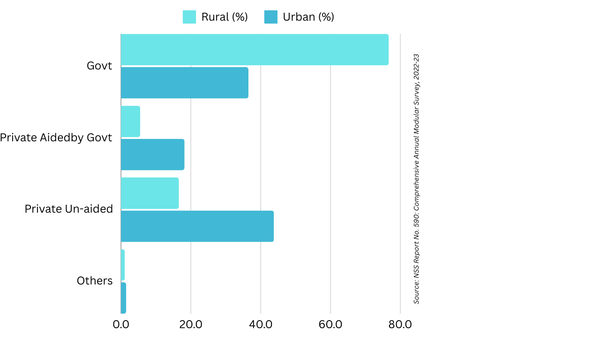In recent years, India’s school enrolment landscape has shifted with a rising percentage of parents preferring private education over public schools, particularly in urban areas. A recent survey Community Analysis of Monitoring Schools (CAMS) carried out by the National Sample Survey Office (NSSO) reveals not just the enrolment gap, but also the socioeconomic causes and geographical variances driving this change.
School enrolment trends: A broad overview
The NSSO survey provides compelling data on primary school enrollment across India, revealing an unmistakable preference for private education in urban areas. According to NSSO’s findings, 43.8% of primary school children in urban settings are enrolled in private schools, a significant contrast to the 36.5% attending government schools.

On the other hand, the CAMS survey shows that nationally, 66.7% of children are enrolled in government schools, with private institutions accounting for 23.4% of enrollments. However, urban-rural discrepancies create a nuanced picture, with urban areas favouring private education despite a national preference for government schools overall.
Regional breakdown: Private vs public enrollment
While urban areas display a stronger inclination toward private schooling, the data uncovers diverse regional trends. In Haryana, 45.6% of primary school children attend private schools, slightly ahead of the 40.2% in government schools.
In Telangana, the preference for private schooling is even more pronounced, with 57.5% of children in private schools versus 30.5% in government schools. Manipur records the highest rate of private enrollment, with an overwhelming 74% of children attending private institutions, compared to just 21% in government schools.
Conversely, in states like West Bengal, Tripura, and Odisha, private schooling remains a minor preference. West Bengal, for instance, reports only 5% of children in private schools, while Tripura and Odisha stand at 6.2% and 6.3%, respectively. These states highlight a strong inclination towards government education, challenging the idea of a uniform shift to private schooling across India.
What drives the urban preference for private schools?
Despite the national average favouring government schools, the breakdown of data reveals a clear urban preference for private education. Several factors help explain this urban trend.
Availability and accessibility
Urban areas typically have a higher concentration of private schools, giving parents more educational choices. With proximity to more institutions, urban families are positioned to consider alternatives beyond government schooling.
Quality perceptions
Many parents perceive private schools as superior in terms of educational quality, infrastructure, and teaching standards, making them more appealing compared to government schools, which often face resource constraints and overcrowded classrooms.
Socioeconomic influence
With generally higher incomes in urban areas, families are often better positioned to afford private schooling. Private education is sometimes viewed as both a marker of status and a pathway to better academic outcomes, reinforcing the demand for private institutions.
Enhanced learning environments
Private schools frequently offer tailored educational experiences, with diverse extracurricular programs, specialised curricula, and smaller class sizes, which align with the aspirations of urban families seeking a holistic education for their children.
Implications and underlying causes: What the figures tell us
This surge in private school enrollment, especially in urban areas, underscores shifting perceptions of education quality and availability. The preference for private institutions suggests a lack of confidence in public schooling, which has historically been plagued by limited resources, outdated facilities, and administrative challenges.
Private schools, by contrast, often project an image of modernity and promise through smaller class sizes, English-medium instruction, and specialised learning approaches.
For policymakers, this data signals the need to address the quality gap in government schools. Without improvements in infrastructure, teaching quality, and accessibility, government schools may continue to struggle against the allure of private alternatives.
Reforms such as enhanced funding, teacher training programs, and initiatives focused on bridging the learning divide could help retain and attract more students to public education.
Understanding the survey: How accurate is the govt data?
The NSSO survey, which gathered this data, was conducted across India, excluding some isolated villages in the Andaman and Nicobar Islands. A large-scale exercise, the survey covered 15,298 primary sample units across rural and urban areas. With a sample size of over 3 lakh households and nearly 13 lakh individuals, this survey provides a comprehensive view of school enrollment trends, giving weight to its findings.
